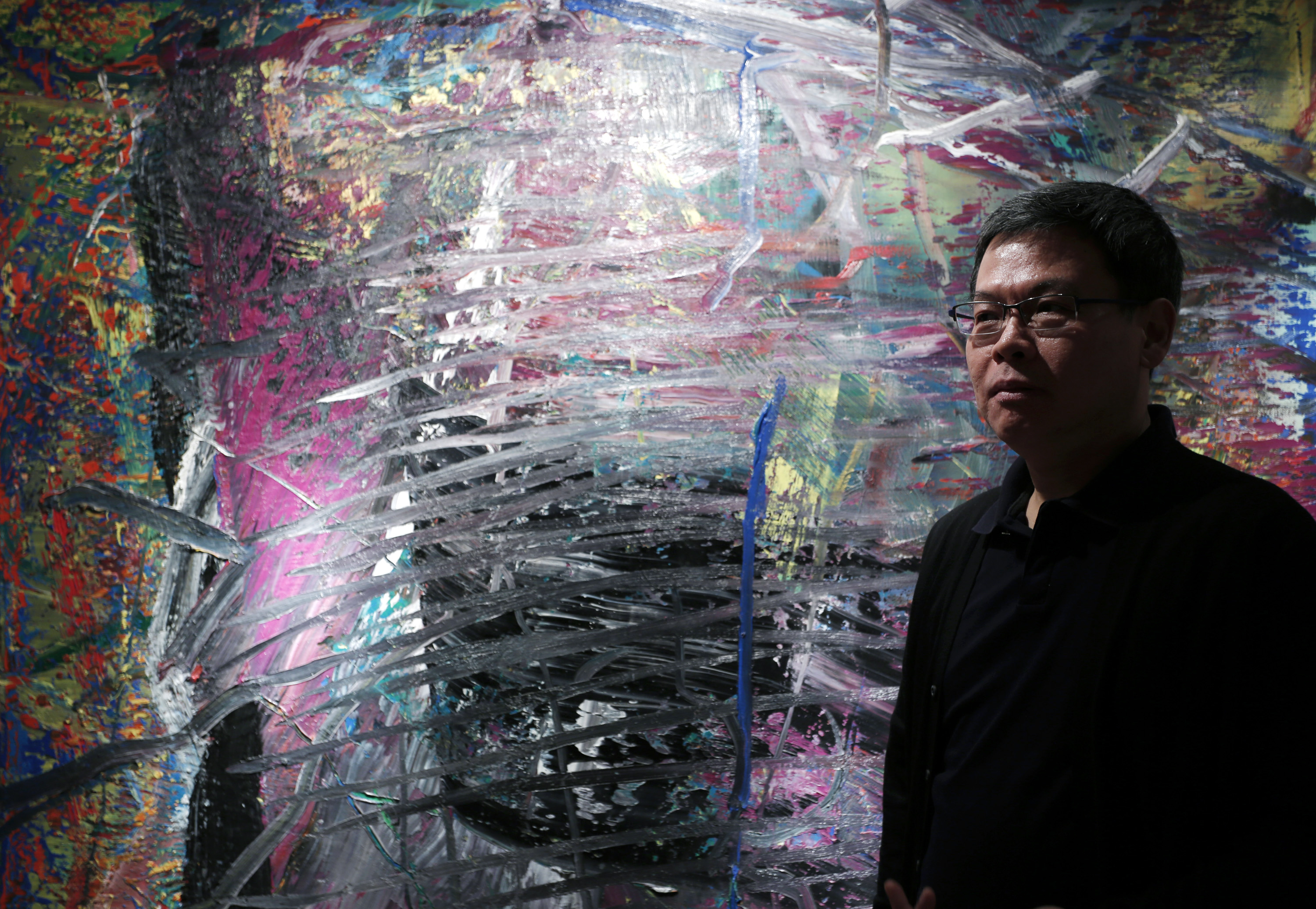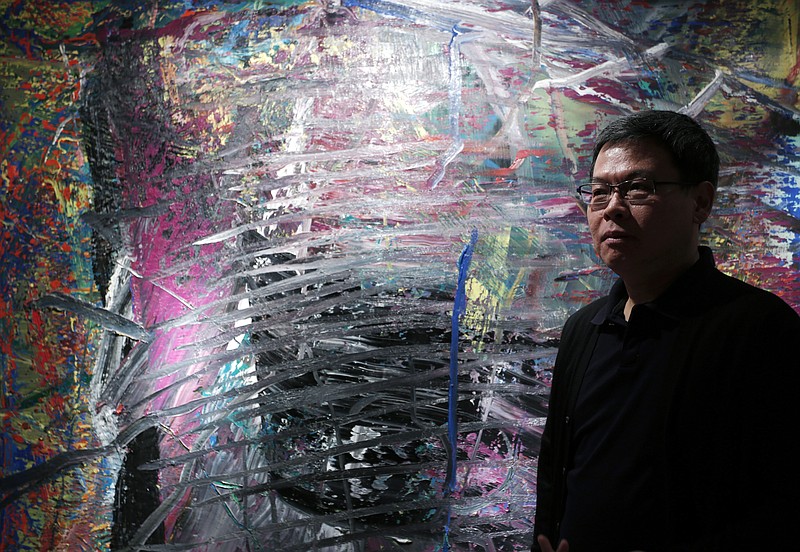 In this photo taken on Monday, April 2, 2012, Indonesian-Chinese farming tycoon Budi Tek poses in front of a painting by Gerhard Richter during an auction preview in Hong Kong. Tek is set to open the De Museum in Shanghai next year featuring Asian and Western contemporary art, after opening his first in Indonesia's capital Jakarta in 2008. While Asia's new generation of wealthy are usually better known for splashing out on extravagant toys such as private jets, mega-sized yachts and supercars, some instead have built big art collections and now aspire to showcase their refined sensibility to a wider audience. (AP Photo/Vincent Yu)
In this photo taken on Monday, April 2, 2012, Indonesian-Chinese farming tycoon Budi Tek poses in front of a painting by Gerhard Richter during an auction preview in Hong Kong. Tek is set to open the De Museum in Shanghai next year featuring Asian and Western contemporary art, after opening his first in Indonesia's capital Jakarta in 2008. While Asia's new generation of wealthy are usually better known for splashing out on extravagant toys such as private jets, mega-sized yachts and supercars, some instead have built big art collections and now aspire to showcase their refined sensibility to a wider audience. (AP Photo/Vincent Yu)KELVIN CHAN
HONG KONG (AP) - Over the past two years Wang Wei and her husband Liu Yiqian dropped a reported $317 million on their hobby. Now they need somewhere to display the collection they've amassed. The solution: a private art museum that Wang hopes will impart some class to China's flashy nouveau riche.
Wang and billionaire investor Liu are part of a new generation of wealthy Asians that is better known for splashing out on extravagant toys such as private jets, mega-sized yachts and supercars. Some, instead, have built big art collections and now aspire to showcase their refined sensibility to a wider audience.
The trend is most apparent in China, where entrepreneurs who have gotten rich off the country's booming economy have been splurging on art, making it the world's biggest fine art market last year for the second year in a row.
As China's best known art collectors, Wang and her husband spent nearly 2 billion yuan ($317 million) on art in the past two years, according to a report in the state-run China Daily that quoted Wang. She declined to confirm the figure, and said "I do not like to talk about how much I spent."
Wang's 10,000 square meter (107,640 square foot) "Long" museum is scheduled to open in Shanghai in late October and will cost 10 million yuan ($1.6 million) a year to run. Aside from giving her a space to show off her collection of Chinese revolutionary and contemporary art, Wang said it will also help her give her nouveau riche compatriots a cultural education.
"The rich housewives have money but do not know how to spend it without shopping," she said. "I want to teach them to be more tasteful."
With that goal in mind, one museum is not enough for Wang. She is planning a second Shanghai museum that will start construction in August and open in October 2013.
More are in the pipeline. Indonesian-Chinese farming tycoon Budi Tek is set to open the De Museum in Shanghai next year featuring Asian and Western contemporary art, after opening his first in Indonesia's capital Jakarta in 2008.
Tek's museum will be located in an old aircraft hangar across the river from the site of the World Expo site in Shanghai's Pudong district, on land that the government is giving to him at a preferential rate. Tek will cover the cost of renovating the building and adding extra wings as well as annual operating costs. He wouldn't say how much he plans to spend, but said "the operating costs will be expensive, buying works will be expensive."
Collector Guan Yi is planning one on the outskirts of Beijing, according to art publications. Industry insiders say wealthy collectors are planning museums around China.
Sustainability is a big issue for would-be museum owners, who need deep pockets to deal with costs, said Magnus Renfrew, director of Art HK, Hong Kong's annual art fair.
"It's many millions of dollars for construction or refurbishment, and that's even before you've got to the art and before you get to the staffing and ongoing costs" said Renfrew. "It's not for the faint hearted."
A growing interest in philanthropy is one reason behind the private museum boomlet. Rapid growth is creating thousands of new millionaires in Asia each year. Their ranks grew to 3.3 million in 2011, surpassing Europe for the first time, according to Merrill Lynch and Capgemini. Between January last year and March this year, China's top 100 philanthropists donated $1.6 billion, according to the Hurun Report, a Chinese rich list. That's about a fivefold increase from 2004 when the list started.
But it also recalls earlier periods in the U.S. and Europe when wealthy art patrons helped build museums that are now world renowned.
In the late 19th century, British sugar magnate Henry Tate help fund the construction of a building to house his collection of Victorian art that he donated to the country, paving the way for the network of renowned museums that bear his name. Members of U.S. oil industrialist John D. Rockefeller's family helped found New York's famed Museum of Modern Art in 1929. Businessman Solomon Guggenheim is best remembered for the iconic New York museum his foundation set up in 1939, which was later named after him.
"It's a complex issue," said Philip Dodd, organizer of the Hong Kong art fair's first private museum forum last year.
"Why did Medici commission so much art? Why did the Vatican commission Michelangelo? Was it philanthropy or was it an exercise of power and display and spectacle? I think all those things are involved in Asia too," said Dodd.
Some 40 private museum owners and collectors from Australia, Japan, Indonesia and China are expected to attend this year's private museum forum at the fair, which will be held May 17-20.
Tek acknowledged that vanity and ego played a role when he started building his art collection, but now he has reverted to what he terms a modest lifestyle. He says his only extravagance is flying first class and he doesn't wear fancy watches or clothes and avoids giving too many media interviews.
"The action of opening the museum is an extension of love to society," said Tek, who is president of Sierad Produce, a $155 million company listed on the Jakarta stock exchange.
"When you see MoMA, with flocks of people everyday, I'm a little bit jealous," said Tek, referring to New York's Museum of Modern Art.
Tek, Wang and other wealthy collectors have turned Hong Kong into the world's third biggest auction hub as they build up their collections of contemporary Chinese art. That segment has boomed in recent years but softened lately.
Gallery owners say choosy buyers have tired of the same artists coming up for sale and are focusing on longer established names. In contrast, during the 1980s Japan bubble, that country's rich were buying up Impressionist masterpieces, Picassos and other Western art.
In the autumn of 2010, Tek paid $6.7 million at a Hong Kong auction for a painting of a yellow baby by Chinese surrealist painter Zhang Xiaogang entitled "Chapter of a New Century Birth of the People's Republic of China II."
In early April, he slipped into Hong Kong again. After an interview with The Associated Press he attended a Sotheby's auction of contemporary Asian art, but stayed in the VIP room to avoid being seen by other bidders.
That sale's highlight was another work by Zhang, a family portrait called "Bloodline-Big Family No. 2." Amid furious bidding, it went to a phone bidder for 46 million Hong Kong dollars ($6 million), three times the opening price.
Sotheby's said the painting and another by Fang Lijun that sold for HK$25 million ($3.2 million) are destined for a private collector's museum in Shanghai. A spokeswoman for Tek wouldn't confirm or deny whether he was the buyer.
